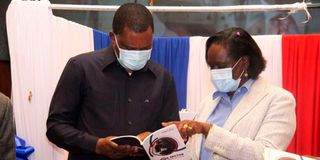62 journalists killed globally last year amid tough work environment

National Assembly Speaker Justin Muturi confers with Broadcasting Principal Secretary Esther Koimett during the launch of the media sector legislative review report at the Serena Hotel in Nairobi on May 3, 2021.
What you need to know:
- The 30th World Press Freedom Day celebrations were hosted virtually by the East African Editors Society and Unesco.
- The celebrations have been held since the Windhoek Declaration for the development of free, independent and pluralistic press in 1991.
At least 62 journalists were killed in the line of duty last year with many others dying from Covid-19 globally.
Unesco Director for International Institute for Capacity Building in Africa (IICBA) Yumiko Yokozeki gave the statistics saying the numbers raised concern.
Dr Yokozeki, who spoke on behalf of Unesco Director-General Audrey Azoula, said the organisation is willing to support the media to provide a safer work environment.
“Whereas we are to ensure flow of information for the public good, we have to be cognisant of the fact that misinformation and hate speech are some of the challenges we have to counter in this digital era where everyone can post anything online,” Dr Yokozeki said.
This emerged during the 30th World Press Freedom Day celebrations hosted virtually by the East African Editors Society and Unesco.
The celebrations have been held since the Windhoek Declaration for the development of free, independent and pluralistic press in 1991.
Mugambi Kiai, the regional Director of Article 19 Eastern Africa, said the environment was becoming harsher for journalists as their security was being threatened by various forces, including the state.
A statement prepared by Article19 Eastern Africa recorded at least 51 cases of attacks against scribes, including nine female journalists in Kenya, between May 2020 and April 2021; a drop from the 59 cases recorded between May 2019 and April 2020.
Out of the 51 incidents, 25 took place between the last and first quarter of 2020 and 2021 respectively. Despite the drop in cases, Mr Kiai noted that the figures were still high and predictable and everything should be done to eliminate the threats to journalists.
“This situation has forced journalists into self-censorship, or forced exile due to the perception that those attacking journalist enjoy impunity, especially state actors,” Article 19 EA stated.
Two weeks ago, police beat and injured nine journalists in Makumi, Mbeere South, Embu County as they covered the forceful eviction by police officers of families from a contested land, said to belong to Tana and Athi River Development Authority (Tarda).
In March 4, supporters of a political party reportedly attacked four journalists —Regina Wangui, Kigotho John Mwangi, Evans Asiba and Elijah Cherutich — while covering a by-election at Milimani Primary School in London Ward, Nakuru County.
Despite being enlisted as an essential worker, David Omurunga, a journalist with Milele FM radio, reported how the police beat him up before arresting him shortly after 8pm while walking home from work.
His attempts to prove he was a journalist and showing the police his identification bore no fruits as he was assaulted and bundled into a waiting police van for violating 8pm to 4am curfew.
Uganda’s situation is no better. Dr Peter Mwesige, the executive director, African Centre of Media Excellence revealed that 180 journalists had been attacked in Uganda in the last seven months alone.
Nation Media Group (NMG) CEO Stephen Gitagama raised concerns over the abductions and enforced disappearance of journalists.
Mumo Muthoki, the Sub-Saharan Representative of the Committee for the Protection of Journalists(CPJ) called on journalists from across Eastern Africa to unite and speak in one voice as a way of ensuring their safety.
Kenya Editors Guild president Churchill Otieno said journalism was no easy task but urged journalists to keep on going despite the numerous challenges.





